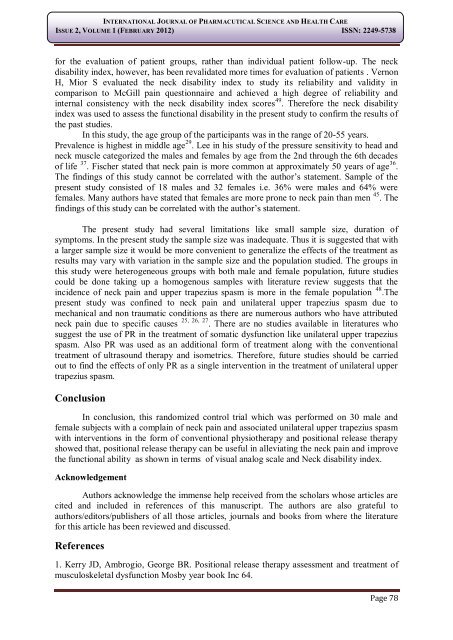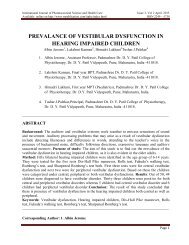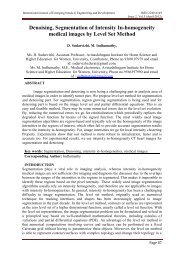Effectiveness Of Positional Release Therapy In Treatment Of Trapezitis
Effectiveness Of Positional Release Therapy In Treatment Of Trapezitis
Effectiveness Of Positional Release Therapy In Treatment Of Trapezitis
You also want an ePaper? Increase the reach of your titles
YUMPU automatically turns print PDFs into web optimized ePapers that Google loves.
INTERNATIONAL JOURNAL OF PHARMACUTICAL SCIENCE AND HEALTH CARE<br />
ISSUE 2, VOLUME 1 (FEBRUARY 2012) ISSN: 2249-5738<br />
for the evaluation of patient groups, rather than individual patient follow-up. The neck<br />
disability index, however, has been revalidated more times for evaluation of patients . Vernon<br />
H, Mior S evaluated the neck disability index to study its reliability and validity in<br />
comparison to McGill pain questionnaire and achieved a high degree of reliability and<br />
internal consistency with the neck disability index scores 49 . Therefore the neck disability<br />
index was used to assess the functional disability in the present study to confirm the results of<br />
the past studies.<br />
<strong>In</strong> this study, the age group of the participants was in the range of 20-55 years.<br />
Prevalence is highest in middle age 29 . Lee in his study of the pressure sensitivity to head and<br />
neck muscle categorized the males and females by age from the 2nd through the 6th decades<br />
of life 37 . Fischer stated that neck pain is more common at approximately 50 years of age 36 .<br />
The findings of this study cannot be correlated with the author’s statement. Sample of the<br />
present study consisted of 18 males and 32 females i.e. 36% were males and 64% were<br />
females. Many authors have stated that females are more prone to neck pain than men 45 . The<br />
findings of this study can be correlated with the author’s statement.<br />
The present study had several limitations like small sample size, duration of<br />
symptoms. <strong>In</strong> the present study the sample size was inadequate. Thus it is suggested that with<br />
a larger sample size it would be more convenient to generalize the effects of the treatment as<br />
results may vary with variation in the sample size and the population studied. The groups in<br />
this study were heterogeneous groups with both male and female population, future studies<br />
could be done taking up a homogenous samples with literature review suggests that the<br />
incidence of neck pain and upper trapezius spasm is more in the female population 48 .The<br />
present study was confined to neck pain and unilateral upper trapezius spasm due to<br />
mechanical and non traumatic conditions as there are numerous authors who have attributed<br />
neck pain due to specific causes 25, 26, 27 . There are no studies available in literatures who<br />
suggest the use of PR in the treatment of somatic dysfunction like unilateral upper trapezius<br />
spasm. Also PR was used as an additional form of treatment along with the conventional<br />
treatment of ultrasound therapy and isometrics. Therefore, future studies should be carried<br />
out to find the effects of only PR as a single intervention in the treatment of unilateral upper<br />
trapezius spasm.<br />
Conclusion<br />
<strong>In</strong> conclusion, this randomized control trial which was performed on 30 male and<br />
female subjects with a complain of neck pain and associated unilateral upper trapezius spasm<br />
with interventions in the form of conventional physiotherapy and positional release therapy<br />
showed that, positional release therapy can be useful in alleviating the neck pain and improve<br />
the functional ability as shown in terms of visual analog scale and Neck disability index.<br />
Acknowledgement<br />
Authors acknowledge the immense help received from the scholars whose articles are<br />
cited and included in references of this manuscript. The authors are also grateful to<br />
authors/editors/publishers of all those articles, journals and books from where the literature<br />
for this article has been reviewed and discussed.<br />
References<br />
1. Kerry JD, Ambrogio, George BR. <strong>Positional</strong> release therapy assessment and treatment of<br />
musculoskeletal dysfunction Mosby year book <strong>In</strong>c 64.<br />
Page 78





